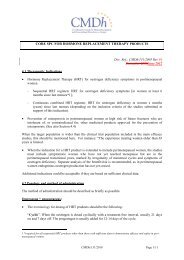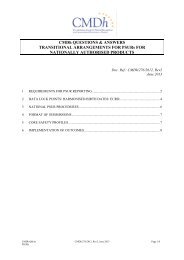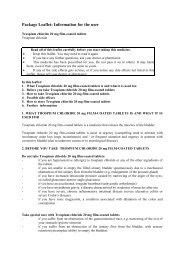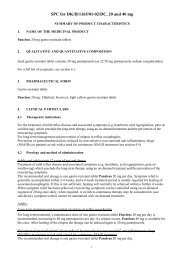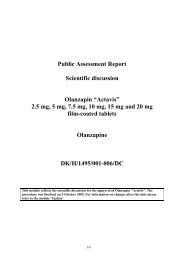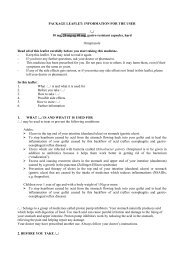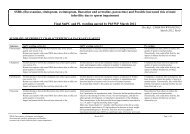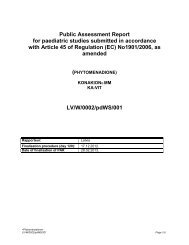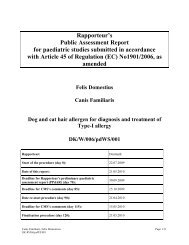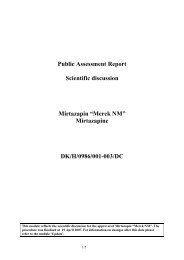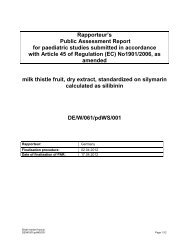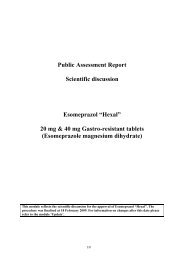Public Assessment Report for paediatric studies submitted in ...
Public Assessment Report for paediatric studies submitted in ...
Public Assessment Report for paediatric studies submitted in ...
Create successful ePaper yourself
Turn your PDF publications into a flip-book with our unique Google optimized e-Paper software.
Peak expiratory flow<br />
Mean Basel<strong>in</strong>e AM and PM PEF were slightly lower <strong>in</strong> the VENTOLIN HFA 90mcg group<br />
than <strong>in</strong> the other two treatment groups. Small mean <strong>in</strong>creases <strong>in</strong> AM and PM PEF was noted <strong>in</strong> both of the<br />
VENTOLIN HFA treated groups over 4 weeks of treatment, however these <strong>in</strong>creases were slightly less <strong>in</strong><br />
the VENTOLIN HFA 90mcg group. At basel<strong>in</strong>e and endpo<strong>in</strong>t the mean AM and PM PEF were<br />
comparable <strong>in</strong> VENTOLIN HFA treated groups<br />
Safety results<br />
Adverse events<br />
The overall <strong>in</strong>cidence of adverse events occurr<strong>in</strong>g both pre-treatment and dur<strong>in</strong>g treatment were<br />
similar among the treatment groups and the adverse events that occurred most frequently <strong>in</strong> this study<br />
were as expected <strong>in</strong> a population of children 243% of subjects and greater than placebo. A total of 33 subjects (43%)<br />
reported at least one AE dur<strong>in</strong>g treatment: 11 subjects (42%) <strong>in</strong> the placebo group, 9 subjects (35%) <strong>in</strong> the<br />
VENTOLIN HFA 90mcg group, and 13 subjects (52%) <strong>in</strong> the VENTOLIN HFA 180mcg group.<br />
System organ classes with the highest <strong>in</strong>cidence of AEs were <strong>in</strong>fections and <strong>in</strong>festations (2<br />
subjects <strong>in</strong> the placebo group, 3 subjects <strong>in</strong> the VENTOLIN HFA 90mcg group, and 5 subjects <strong>in</strong> the<br />
VENTOLIN HFA 180mcg group) and <strong>in</strong>vestigations (e.g., ECG and laboratory f<strong>in</strong>d<strong>in</strong>gs-no subjects <strong>in</strong><br />
the placebo group, 3 subjects <strong>in</strong> the VENTOLIN HFA 90mcg group, and 4 subjects <strong>in</strong> the VENTOLIN<br />
HFA 180mcg group).<br />
A total of 3 subjects had one AE each considered by the <strong>in</strong>vestigator to be potentially drug<br />
related (2 subjects <strong>in</strong> the VENTOLIN HFA 90mcg group and 1 subject <strong>in</strong> the VENTOLIN HFA 180mcg<br />
group). In the VENTOLIN HFA 90mcg group, drug-related AEs were “Blood alkal<strong>in</strong>e phosphatase<br />
<strong>in</strong>crease” and “Electrocardiogram QT corrected <strong>in</strong>terval prolonged.” In the VENTOLIN HFA 180 mcg<br />
group, the drug-related AE was psychomotor hyperactivity. These AEs did not lead to subject withdrawal<br />
from the study<br />
Signs and symptoms of adrenergic stimulation<br />
At all on-treatment assessments, most subjects (91-100%) had no tremor present. No moderate or<br />
severe tremor was reported at any time dur<strong>in</strong>g the study. At the post treatment assessment on Day 1, mild<br />
tremor was reported <strong>for</strong> two subjects (one each) <strong>in</strong> the VENTOLIN HFA 90 and 180mcgs group.<br />
However the subject <strong>in</strong> the VENTOLIN HFA 180mcg did not have any further episodes of tremor after<br />
week 1, dur<strong>in</strong>g the study. Mild tremor was reported <strong>for</strong> ≤2 subjects at each subsequent treatment<br />
assessment. At Week 4, mild tremor was reported <strong>in</strong> 1-2 subjects <strong>in</strong> the VENTOLIN HFA treatment<br />
groups and <strong>in</strong> no subjects <strong>in</strong> the placebo treated group.<br />
FSII(R) questionnaire<br />
Functional Status II (R) was assessed by the parent/guardian-<strong>for</strong> the study site adm<strong>in</strong>istered<br />
FSII(R) questionnaire <strong>for</strong> each subjects. Mean Basel<strong>in</strong>e scores ranged from 82.6 to 85.6 and <strong>in</strong>dicated a<br />
high pre-treatment function<strong>in</strong>g. There was improvement <strong>in</strong> scores over the treatment period <strong>in</strong> all<br />
treatment groups (adjusted mean Endpo<strong>in</strong>t scores ranged from 88.1 to 92.0). However no significant<br />
differences were observed between the VENTOLIN HFA treatment groups and the placebo treatment<br />
group<br />
Cl<strong>in</strong>ical laboratory assessment<br />
No AEs of hypokalemia were reported<br />
Blood glucose values rema<strong>in</strong>ed fairly consistent across the treatment groups over the course of<br />
the study.<br />
Hyperglycemia was reported <strong>for</strong> one subject <strong>in</strong> the placebo group.<br />
ECG monitor<strong>in</strong>g<br />
Most subjects had normal cardiovascular assessments and results were comparable <strong>in</strong> the<br />
treatment groups. There were no cl<strong>in</strong>ically relevant differences <strong>in</strong> the mean change from basel<strong>in</strong>e <strong>in</strong> the<br />
QT <strong>in</strong>terval between treatment groups.<br />
Salbutamol F<strong>in</strong>al <strong>Public</strong> <strong>Assessment</strong> <strong>Report</strong><br />
RO/W/0001/pdWS/001<br />
Page 26/76



